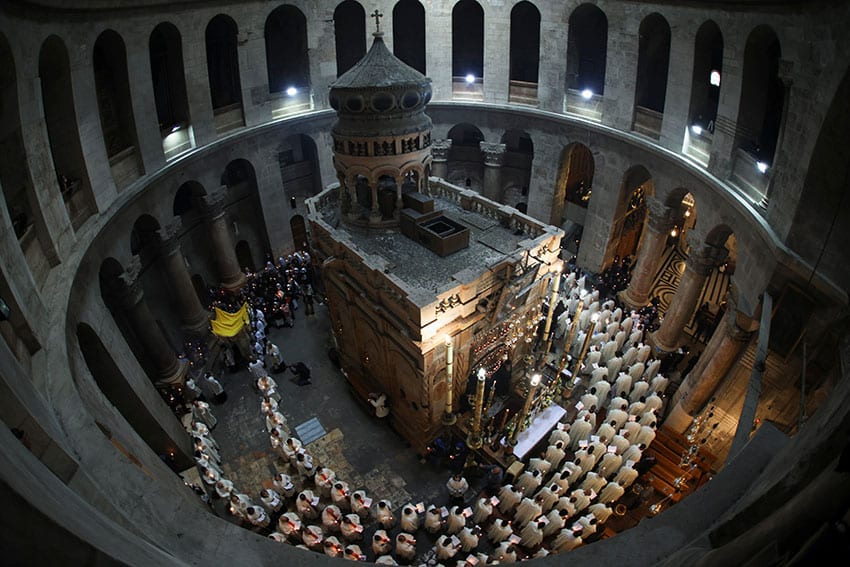
Dear Fr John Flader, I know that St Helena ordered the building of the Church of the Holy Sepulchre in Jerusalem and the Church of the Nativity in Bethlehem, but someone told me there was a third. Can you tell me if this is true and, if so, which church it is?
It is true that St Helena, the mother of Emperor Constantine I, ordered the building of three churches in the Holy Land, the third being the Church of the Ascension on the Mount of Olives, east of Jerusalem. The three have become known as the Helena churches. As I am writing from the Holy Land and have visited these churches, I think it would be of great interest to write a separate article on each of them, since they have so much importance for our understanding of the life of Christ and the origins of our faith.
It will be helpful to recall that in 312 AD Constantine had a vision of Jesus Christ before the decisive Battle of the Milvian Bridge outside Rome, and he converted to the Christian faith shortly thereafter. The following year, with the Edict of Milan, he ended the persecution of the church.
In 326 he sent his mother, Empress Helena, to try to find the sites at which Christ was born, died and was buried, rose from the dead and ascended into heaven. I have written before in my book Question Time 2, q. 273, about how she found both the place where Jesus was crucified and the holy cross itself.
When St Helena arrived in Jerusalem to look for the burial place of Jesus, she found that around the year 135 AD, the emperor Hadrian, in order to prevent Christians going to pray at the site, had built over it a temple to Jupiter and, alongside it, a statue of Venus.
Basing herself on tradition and with the help of the bishop of Jerusalem, Macarius, and the bishop of Caesarea, Eusebius, Helena had the pagan shrines demolished. Digging done immediately beneath the temple revealed evidence of the tomb of Jesus and close by three crosses, one of which was identified as the true cross of Jesus when a dying lady was healed when touched with the cross.
St Eusebius of Caesarea described the discovery in these words: “But as soon as the original surface of the ground, beneath the covering of earth, appeared, immediately, and contrary to all expectation, the venerable and hallowed monument of our Saviour’s resurrection was discovered” (Vita Constantini, 3, 28).
St Helena then ordered the construction of a church over the Holy Sepulchre. The area of the tomb of Jesus was isolated by carving away the surrounding rock, leaving just the sepulchre itself within a cube of stone. Surrounding the sepulchre she built a marble chapel now called the Aedicule, which at present stands at the centre of a circular mausoleum known as the Anastasis (resurrection), over which is a great dome with an opening at the top. The church was consecrated on 13 September 335. Although the same structure is there today, few elements remain of the original fourth-century building.
Today, after numerous additions and modifications over the centuries, including many chapels and a sacristy, and with a steep stairway leading up to the nearby site of the crucifixion, the Aedicule remains much as it was in St Helena’s time. One enters it through a door to a first chapel, known as the Chapel of the Angel, in memory of the angel who appeared to the holy women to announce Jesus’ resurrection. In this chapel is a pedestal containing a small fragment of the circular stone which was rolled into place to close the tomb. Until the destruction of the edifice in 1009, the whole stone was preserved there.
From the Chapel of the Angel one passes through a low passageway to the chapel of the sepulchre itself, where pilgrims venerate a slab of stone covering the rock where Jesus’ body was laid, and where he rose from the dead. In 2016 this slab was removed, exposing the original rock.
Apparently, when this was done, three out of four scientific instruments stopped working, as did one of the computers.
Today, just inside the entrance to the church of the Holy Sepulchre, there is a slab of stone commemorating the stone on which the body of Jesus was placed and anointed before it was laid in the tomb. A visit to this church fills the pilgrim with great faith and love for Christ.
